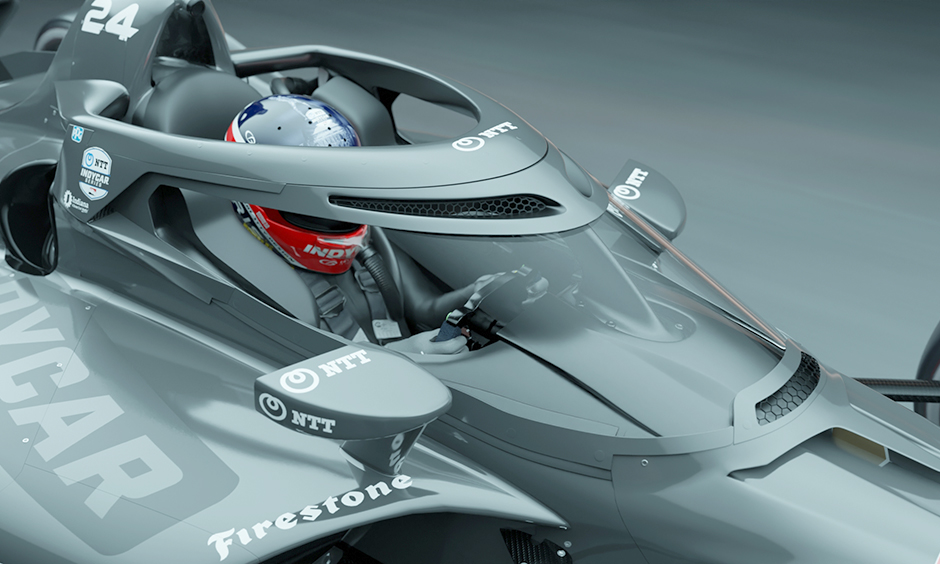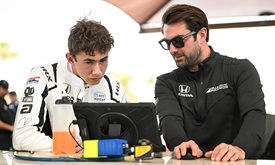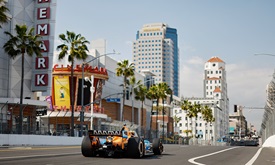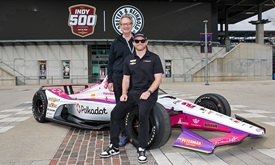Improved, Lighter Aeroscreen To Debut at Long Beach
APR 16, 2024
New Design Also Enhances Driver Cooling
An updated, lightweight aeroscreen will be introduced as mandatory equipment on all NTT INDYCAR SERIES cars for road and street course races, starting with the Acura Grand Prix of Long Beach this weekend.
Among the biggest NTT INDYCAR SERIES safety enhancements in recent history, the series partnered with Red Bull Advanced Technologies to introduce the aeroscreen for the 2020 season. The safety device enhances driver cockpit protection with a ballistic windscreen from PPG anchored by a titanium framework produced by Pankl. INDYCAR mandated its use by all teams at all track disciplines (ovals, permanent road courses and temporary street circuits).
That was version 1.0. Meet version 2.0.
The lighter screen debuting this weekend features vents for increased overall driver cooling and a top front duct directing air to the driver’s chest. The ducting is 3D printed in rubber to prevent hand injuries in an accident.
“One of the objectives of doing a 2.0 version was to save weight,” said Tino Belli, director of aerodynamic development for the NTT INDYCAR SERIES. “Then we've taken that opportunity to also make the styling nicer, improve the driver ventilation, and make the thinner polycarbonate as strong as the thicker polycarbonate.”
The revised aeroscreen boasts a sleeker look while also dropping weight from 18.8 pounds on the first version to 14.5 pounds. That’s in addition to a new topologically optimized, 3D-printed titanium aeroscreen frame that was mandated at the beginning of the season. The frame is as strong as the original but weighs 6.8 pounds less. Combined, it’s a total system weight reduction of 11.1 pounds.
Weight reduction and safety enhancements of the new aeroscreen reduce downforce by approximately 35 pounds, Belli said.
Driver feedback from the original design of the aeroscreen also indicated the need for more cooling, and Belli and other INDYCAR officials listened.
During a typical NTT INDYCAR SERIES race, a drivers’ heart rate reaches 85-95 percent of capacity, translating to 150-200 beats per minute. Their body temperatures can rise to over 100 degrees Fahrenheit while wearing layers of protective clothing.
Following an evaluation to search for areas of improvement to make the screen lighter, a key area stood out to add venting for driver cooling. Vents could be added without a significant redesign because driver feedback indicated the wide range of vision in the original design was not needed.
“We learned over the years where the limit of the vision was,” Belli said. “In the first version, we were conservative. We gave them a wider field of vision. We found out that they didn't need it. So, now we’ve used that space to create a vent which comes underneath the titanium top frame and it gets ducted down to blow air toward the driver’s chest.”
An optional filter can be added to the honeycomb mesh to help filter any dust from entering the cockpit.
The introduction of the revised aeroscreen comes ahead of schedule as the new equipment was scheduled to debut in May’s Sonsio Grand Prix at the Indianapolis Motor Speedway road course. With sufficient supply for the entire paddock, INDYCAR officials decided to bring forward this important piece of safety equipment at Long Beach.
Belli said this project has been momentous.
“The aeroscreen has been massively important as a total driver cockpit safety solution that has already paid huge dividends many times,” he said.





















